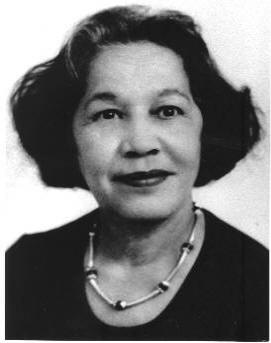Childhood
Irene Britton Smith was born in Chicago on December 22, 1907. Her father was a clerk in a manufacturing company and her mother was a self-taught pianist. When Irene was 10, her parents separated and she was sent to a Catholic boarding school for a year. Later, she and her sister took piano lessons from V. Emanuel Johnson, who made them play duets. When Irene was in high school, she developed an interest to learn how to play the violin and started to teach here herself on her sister’s instrument.
Education
After high school, Irene had ambitions to study music at Northwestern University but her parents couldn't afford it. Instead, she attended a two-year course at Chicago Normal School to prepare herself to teach in the elementary grades. After being assigned to teach primary grades in the Chicago public schools, she decided to take a course in music theory, which she had longed to study for many years. She took one course a year at the American Conservatory, beginning with theory and harmony for two years, then progressing through form and analysis, and counterpoint.
Berean Baptist Church
During the 1930s, Irene attended the Berean Baptist Church along with a good number of other musicians who were well-known in the black community. These included Estella Bonds, church organist, and her daughter, Margaret. Smith knew the Bonds family well, and was good friends with Estella's sister Helen. Irene played violin in the all-black Harrison Ferrell Symphony Orchestra, which rehearsed at the church and gave yearly concerts at Kimball Hall. She was later a member of the student orchestra at the American Conservatory.
Personal Life
In 1931, Irene married Herbert E. Smith. Herbert had greater ambitions, and returned to school for a master's degree in chemistry at Bradley University in Peoria. But after he finished his degree, he found that it was still very difficult for qualified blacks to get jobs in Illinois. During the 1940s and 1950s, Irene and her husband lived apart while they both pursued their degrees. She recalled that he would send her a dozen roses on their anniversary, even during their years of separation. They later reunited, and he eventually worked for the U.S. Department of Agriculture. The couple remained childless, and in December 1975 her husband passed away.
Irene and Florence
In 1936, Smith wrote to Florence Price after hearing her give a talk. Price responded with a letter saying, "It was very kind of you to say you enjoyed my little talk at Lincoln Center, and it makes me happy indeed to know that you received encouragement from it. That you find the study of composition such a pleasure indicates that we may expect to hear from you some of these days. I should be very glad to see some of your work if you care to call a few days ahead of time and make an appointment." Smith was too shy to accept Price's invitation. But Price's words encouraged her, and she decided to work toward a degree in theory and composition at the American Conservatory, with the approval of her instructor, Stella Roberts.
Irene's Music
Smith's compositions started to gather momentum in 1940-41. During these years, she wrote several ambitious works including Passacaglia and Fugue in C-sharp Minor, Invention in Two Voices for piano, Psalm 46 for chorus and baritone, and Reminiscence for violin and piano. In 1943, after 11 years of study, she completed her bachelor's degree in composition at the American Conservatory. In 1946, Irene’s Fairest Lord Jesus, written for women's voices and organ, was accepted for publication by the prestigious New York publishing firm G. Schirmer. That year she was on sabbatical leave from the Chicago public school system and went to New York for graduate study at the Juilliard School of Music.
Continued Education
Upon returning to Chicago and her classroom teaching, Smith resumed studies in composition with Leon Stein at De Paul University. She spent several summer vacations away from Chicago, studying with well-known composers and teachers. In the summer of 1948, she studied contemporary harmony at the Eastman School of Music with Wayne Barlow. In 1949, she was at Berkshire Music Festival in Tanglewood, working with Hugh Ross in choral conducting and studying composition with Irving Fine. She met Julia Perry and showed her some of her compositions. Smith completed her master's degree in theory and composition at De Paul University in 1956. In the summer of 1958, she fulfilled a dream to study with the famed teacher Nadia Boulanger at the American Conservatory at Fontainebleu, France.
Chicago public schools
Irene Britton Smith taught Reading in the Chicago Public Schools for more than 40 years and last taught at Pershing Elementary School, from 1958 to the year of her retirement, 1978. She adopted the phono-visual method of teaching how to read after attending a demonstration at Northwestern University in 1957. For the next decade, her energies went into giving workshops, and promoting and using this teaching technique. Smith's concern for young people was also evident in her volunteer work as a docent for the Chicago Symphony Orchestra in the Chicago public schools, which she began soon after her retirement from classroom teaching in 1978.
Later years
For the last few years of her life, Smith lived in the Montgomery Place Retirement Home on Chicago's South Shore Drive. During this time, her Sonata for Violin and Piano was published and issued on a CD recording. Unfortunately, she had difficulty recognizing her own music because she suffered from Parkinson's disease and Alzheimer's. On February 15th, 1999, at the age of 91, she died of complications from these diseases. Services were held at the Griffin Funeral Home, and she was buried in Lincoln Cemetery, where Florence Price is also buried. In accord with her wishes, her papers and music scores were given to the Center for Black Music Research (CBMR) at Columbia College Chicago.
